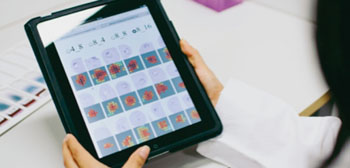Image Recognition Software Increases Accuracy of Malaria Diagnosis
By LabMedica International staff writers
Posted on 01 Sep 2014
A facial recognition software program has been adapted to assist in the identification of the malaria parasite by microscopic examination of blood smears.Posted on 01 Sep 2014
To develop a simpler, more effective visual method to diagnose malaria, a team of Scandinavian researchers coopted computer vision algorithms similar to those used in facial recognition systems. The program operates on a digitalized image of a thin layer of blood that had been smeared on a microscope slide. The algorithm analyzes more than 50,000 red blood cells per sample and ranks them according to likelihood of the cell being infected. The program then generates a panel of images of about a hundred cells most likely to contain the parasite. This panel is then evaluated by an experience microscopist who makes the final diagnosis.

Image: The parasite detection method is based on computer vision algorithms similar to those used in facial recognition systems combined with visualization of only the diagnostically most relevant areas. Tablet computers can be utilized in viewing the images (Photo courtesy of the Institute for Molecular Medicine).
To verify the technique Giemsa-stained thin blood films with Plasmodium falciparum ring-stage trophozoites (n = 27) and uninfected controls (n = 20) were digitally scanned with an oil immersion objective to capture approximately 50,000 erythrocytes per sample. Parasite candidate regions were identified based on color and object size, followed by extraction of image features (local binary patterns, local contrast, and Scale-invariant feature transform descriptors) used as input to a support vector machine classifier. The classifier was trained on digital slides from ten patients and validated on six samples.
From each digitized area of a blood smear, a panel with the 128 most probable parasite candidate regions was generated. Two expert microscopists were asked to visually inspect the panel on a tablet computer and to judge whether the patient was infected with P. falciparum. The method achieved a diagnostic sensitivity and specificity of 95% and 100% as well as 90% and 100% for the two readers respectively using the diagnostic tool. Parasitemia was separately calculated by an automated system and the correlation coefficient between manual and automated parasitemia counts was 0.97.
"We are not suggesting that the whole malaria diagnostic process could or should be automated. Rather, our aim is to develop methods that are significantly less labor intensive than the traditional ones and have a potential to considerably increase the throughput in malaria diagnostics," said senior author Dr. Johan Lundin, research director at the Institute for Molecular Medicine (Helsinki, Finland).
The study with complete description of the new diagnostic approach was published in the August 21, 2014, online edition of the journal PLOS One.
Related Links:
Institute for Molecular Medicine














